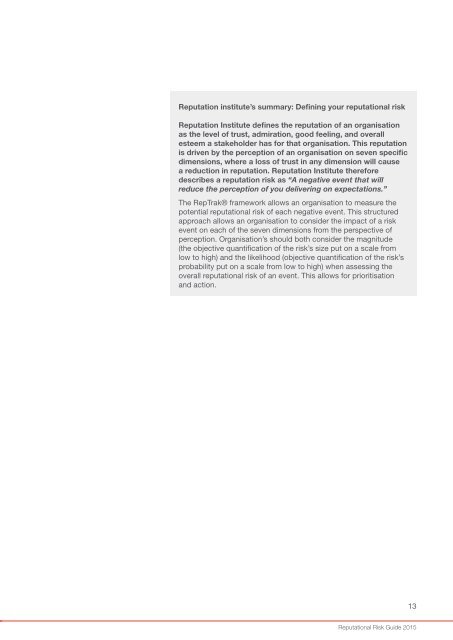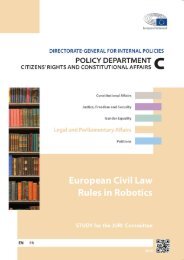Defining and managing reputation risk
Tjqga
Tjqga
You also want an ePaper? Increase the reach of your titles
YUMPU automatically turns print PDFs into web optimized ePapers that Google loves.
Reputation institute’s summary: <strong>Defining</strong> your <strong>reputation</strong>al <strong>risk</strong><br />
Reputation Institute defines the <strong>reputation</strong> of an organisation<br />
as the level of trust, admiration, good feeling, <strong>and</strong> overall<br />
esteem a stakeholder has for that organisation. This <strong>reputation</strong><br />
is driven by the perception of an organisation on seven specific<br />
dimensions, where a loss of trust in any dimension will cause<br />
a reduction in <strong>reputation</strong>. Reputation Institute therefore<br />
describes a <strong>reputation</strong> <strong>risk</strong> as “A negative event that will<br />
reduce the perception of you delivering on expectations.”<br />
The RepTrak® framework allows an organisation to measure the<br />
potential <strong>reputation</strong>al <strong>risk</strong> of each negative event. This structured<br />
approach allows an organisation to consider the impact of a <strong>risk</strong><br />
event on each of the seven dimensions from the perspective of<br />
perception. Organisation’s should both consider the magnitude<br />
(the objective quantification of the <strong>risk</strong>’s size put on a scale from<br />
low to high) <strong>and</strong> the likelihood (objective quantification of the <strong>risk</strong>’s<br />
probability put on a scale from low to high) when assessing the<br />
overall <strong>reputation</strong>al <strong>risk</strong> of an event. This allows for prioritisation<br />
<strong>and</strong> action.<br />
13<br />
Reputational Risk Guide 2015



